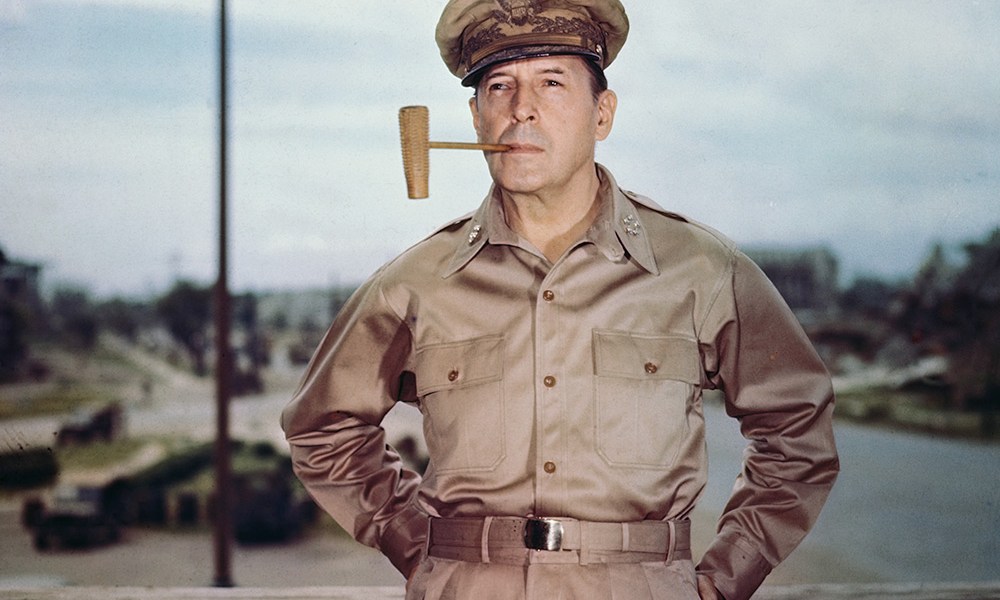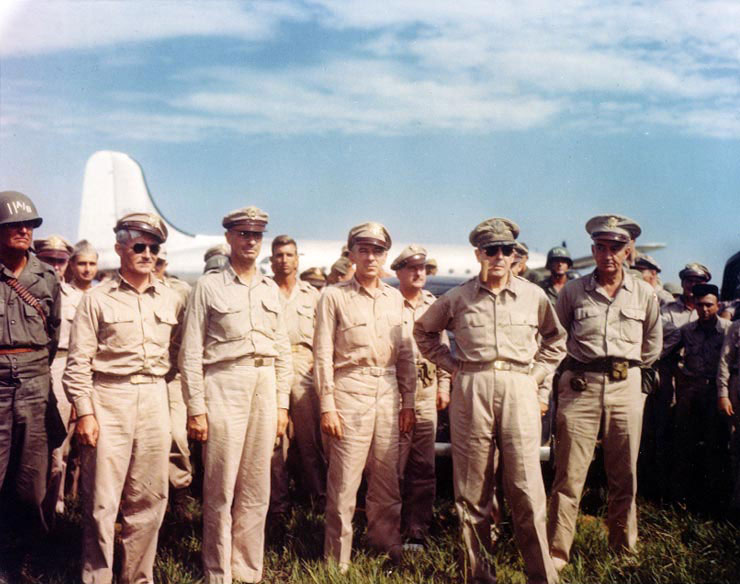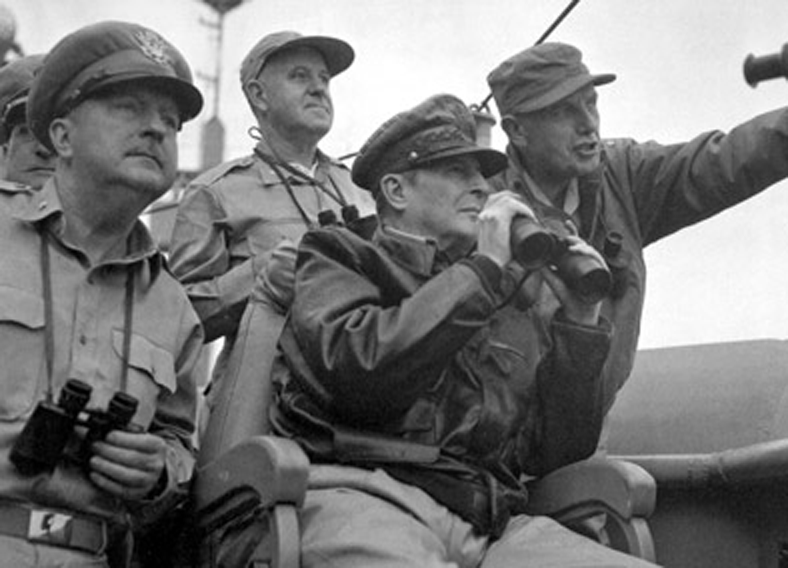

General Douglas MacArthur: A Man of the People?
David McCormack — December 12, 2015
By the summer of 1945, much of Japan lay in ruins, its cities having been incinerated by the American bomber fleets. Industry had been shattered, the merchant fleet all but destroyed. Two million people had perished, a third of them civilians. Never in modern times had a country been so devastated by war. On August 15, Emperor Hirohito broke with tradition by broadcasting to the nation. His address was couched in courtly language peppered with classical phrases rather than colloquial Japanese. Despite this, many understood his meaning when he informed the stunned and bewildered nation that, “to continue the war would ultimately mean the extinction of our people and the utter destruction of human civilisation”. However, not all heeded the Emperor’s message.
On August 22, Air Corps units based on the Kamikaze home base at Atsugi airfield near Tokyo dropped leaflets over the capital encouraging the population to “rise up against their leaders and repel the invasion”. This call to arms was unsuccessful as it failed to inspire a general uprising. However, small military cliques in the capital did respond, one such group consisting of 400 soldiers raised the banner of revolt by occupying Ueno Hill. When ordered to desist by higher authorities, the soldiers, who were mainly officers, committed suicide. That same day, police units attacked an “Ultra Rightist Brotherhood” making a stand on Atago Hill. By the following day, order had been restored and imperial edicts were issued to military units to comply with Allied orders for them to lay down their arms.
For many ordinary Japanese people, the end of the war had been greeted with a strong sense of release, followed by a search for answers as to why the war had been lost. The people’s mood had been keenly observed by Kido Koichi, the lord keeper of the privy seal and the Emperor’s closest confidante, who noted in a diary entry how the people “felt a great burden had been lifted”. With the lifting of that burden, the Japanese people contemplated the prospect of occupation with a combination of relief and fear of what was to come.
"MacArthur also displayed the imperious aloofness with which the Japanese people could both identify and respect."
The occupation of Japan was to be administered exclusively by the United States, as such there were to be no zones of occupation as in Europe. The Soviets had wanted to station troops in Japan, but were politically outmanoeuvred. For its part, Great Britain, the long time ally of the United States, was too exhausted to stake any territorial claims. The U.S. administration was to be headed by General Douglas MacArthur. He was the obvious choice for this demanding role, an able and eloquent administrator, MacArthur also displayed the imperious aloofness with which the Japanese people could both identify and respect.
The occupation began in a low-key manner on August 28, when a C-46 Skytrain transport aircraft circled the Atsugi airfield, before finally touching down at 08.28 hrs. This was the lead aircraft in a flight of 16 bearing Colonel Tench, commanding his advance party on behalf of the Supreme Commander for the Allied Powers. The landing of the C-46 caused some anxiety on the ground as the United States representatives were one hour early and no one was ready to receive them. General Seizo Arisue commanding the Atsugi reception committee quickly recovered his composure and after assembling his reception committee set off to meet the American representatives. After proffering a stiff salute to Tench, the American group was led towards a tent in the centre of the airfield which served as the reception area. The atmosphere in the tent was frosty, strict military protocol taking precedence. When Tench was offered a drink of orange punch and some food, he instinctively refused, thinking that it had been poisoned. Only after Arisue took a drink himself did Tench relent with a resultant relaxation of tension within the tent.
“With his corncob pipe clenched firmly between his teeth, MacArthur decended the ladder to shake hands with Eichelberger, saying ‘Bob, from Melbourne to Tokyo is a long way, but this seems to be the end of the road'”.
Following a perceptible thaw in the atmosphere, discussions began with Tench outlining his mission as being to reconnoiter the airfield to determine suitability for follow up operations, establish supply and support services, coordinate improvements on the airfield and to establish communications with General Headquarters. Thanks to a pervading tone of increased co-operation and goodwill, rapid progress was made. During the course of discussions, a second flight of 15 aircraft arrived over the airfield at 09.35 hrs, followed by a third at 11.00 hrs. Meanwhile, Japanese labour battalions set about repairing and lengthening the runways to accommodate additional B-29 and C-54 aircraft. The work was completed quickly, much to Tench’s relief as his advance group had as yet established little more than a toehold on Japanese territory.
On August 30, elements of 11th Airborne Division deplaned on the newly repaired runways from 07.00 hrs onwards, thus providing a much more substantial occupying force. One of the first aircraft to land carried Major General Joe Swing, the division’s battle-hardened commanding officer. Swing assumed command from Tench and began conferring with Arisue regarding arrangements for General Robert Eichelberger’s imminent arrival, and that of MacArthur, who was expected later that day. Swing’s four engined transport aircraft were landing every two to three minutes, bringing in additional troops and supplies.
The last C-54 to land was MacArthur’s personal aircraft Bataan II, in which he was discussing the future administration of Japan with his military secretary and chief of psychological warfare Brigadier General Bonner Fellers. After touching down at 14.29 hrs, MacArthur paused at the top of the ladder and was heard to say “This is the payoff”. With his corncob pipe clenched firmly between his teeth, MacArthur descended the ladder to shake hands with Eichelberger, saying “Bob, from Melbourne to Tokyo is a long way, but this seems to be the end of the road”. A cavalcade of decrepit old cars and trucks, led somewhat incongruously by a spluttering bright red fire engine ferried the Supreme Commander and his staff to the New Grand Hotel, serving as temporary headquarters in Yokohama. MacArthur was shown to room 315 personally by the hotel owner Yozo Namura. A further 159 general officers were quartered at the hotel, including the former British commander of Singapore, General Arthur E. Percival and the defender of Corregidor, General Jonathan Wainwright.

MacArthur arrives at Atsugi, Japan
MacArthur quickly established his administrative priorities and saw his first task as feeding the population. To this end he established army kitchens and brought in 3,500,000 tons of food from bases across the Pacific. When a Congressional Committee later questioned MacArthur’s actions, his answer was unequivocal, “give me bread or give me bullets”. The arrival of transports laden with supplies did much to reduce Japanese anxieties and paved the way for the occupation to proceed in an orderly fashion. The American troops were, on the whole, well behaved (MacArthur had introduced the death penalty for rape), and the population readily accepted the security offered by the new administration.
The occupation may be divided into four distinct phases: demobilisation, constitutional and religious reform, political reform and economic reform. The first phase, that of disarming and repatriating in excess of 6,000,000 soldiers was carried out within a year. The General Staff was abolished and military officers barred from public service. War criminals were brought before an international tribunal, seven leading personalities including General Tojo were hanged.
The second phase began with a meeting between MacArthur and the Japanese Foreign Minister, Mamoro Shigemitsu, on September 3. During the meeting Shigemitsi stated the Emperor’s determination to cooperate and assured MacArthur that the government “stood ready and eager to do his bidding”. Shigemitsu was successful in persuading MacArthur to shelve plans to implement direct military rule stating that the most effective method of enforcing the Potsdam protocols was to work directly “through the Japanese government instructed by the Emperor”. This scenario fitted in with MacArthur’s plans, and so the scene was set for his historic meeting with the incumbent of the Chrysanthemum Throne.
Two weeks after his meeting with Shigemitsu, MacArthur had his first face to face meeting with the Emperor at the United States Embassy in Tokyo. The Emperor arrived with his retinue dressed in a rather formal black ensemble, which provided a stark contrast with MacArthur’s more casual appearance. To many Japanese officials, the image of a tieless MacArthur wearing a slightly creased uniform and towering over the Emperor was deeply humiliating, symbolising as they saw it, his effective usurping of the throne. Nonetheless, the meeting went well, with MacArthur greeting the Emperor with the words, “you are very, very welcome sir”. No stenographic records were kept of the 50-minute meeting which revolved around MacArthur’s desire to promote the Emperor as “the first gentleman of Japan”. As such, the question of possible war crimes charges were not raised as MacArthur firmly believed that the Emperor not only held the key to Japan’s surrender, but also to postwar change.
In keeping with MacArthur’s reform priorities, a new constitution came into effect on May 3, 1947. Reforms were largely carried out by Japanese bureaucrats, technocrats and outside advisors, with MacArthur’s staff providing the directives. MacArthur placed anti-militarist ideas at the very centre of the new national charter. The so called “Peace Clause”, enshrined within Article 9 of the constitution, effectively outlawed war as a means of settling international disputes. Article 9 proscribed the possession of the means to wage aggressive war. However, the provisions of the constitution did not in any way deny Japan’s inherent right to self defence. As such, the Japanese government subsequently interpreted Article 9 as allowing them to possess the minimum level of armed forces and combat power needed to exercise their right to self defence.
“Political reform served as the harbinger of economic and social reform as American planners had been correct in their assumption that a more equitable distribution of wealth, opportunity and power would ensure the future stability of Japan as a peaceful and democratic nation.”
The militarists in Japan had decreed that Shinto would be the state religion. On December 15, the new administration set about severing the close ties between Shinto and the state. The Directive for Disestablishment of State Shinto was a powerful indictment of the abuses of religion by the state. Whilst not destroying Shinto, the Directive sought to “prevent recurrence of the perversion of Shinto theory and beliefs into militaristic and ultra-nationalist propaganda designed to delude the Japanese people and lead them into wars of aggression”. Some elements of Shinto were allowed to remain, concurrent with the cleansing of nationalist and militaristic elements in the aforementioned Article 9 of the constitution.
The third stage of instutionalising reform involved two major changes to Japan’s political structure. The Emperor was not only reduced to being a symbol of the state with little political influence, but also to being a mere mortal. His Humanity Declaration, partly derived from the Five Charter Oath of 1868, was issued as part of a New Year’s statement on January 1, 1946. In this declaration in the form of an imperial rescript, he agreed to purge himself of divine pretensions by stating that “the ties between us and our people have always stood upon mutual trust and affection. They do not depend upon mere legends and myths. They are not predicated on the false conception that the Emperor is divine”. By repudiating the concept of being a living god, the Emperor greatly facilitated the promulgation of the new constitution.
The second change within the political sphere came the abrogation of old laws and replacing them with new civil and criminal codes. Reform of the civil code eliminated the legal foundations of the patriarchal family system, thus strengthening the position of women in areas such as inheritance and divorce. In addition, long established authoritarian structures such as the Home Ministry which controlled the Police and prefectural governments were abolished, the largest surviving department being renamed the Autonomy Ministry. Political reform served as the harbinger of economic and social reform as American planners had been correct in their assumption that a more equitable distribution of wealth, opportunity and power would ensure the future stability of Japan as a peaceful and democratic nation.
The fourth and final phase of the occupation authorities reforms began with a purge of the financial magnates (Zaibatsu). The Zaibatsu families had their assets frozen and the bulk of their capital seized by the government in a general levy. Great families, such as the 17th-century house of Mitsui faded into economic and political obscurity. The land reform programme improved the situation of the tenant farmer. Educational reform produced a generation of students free from the restrictive discipline of the past.
In 1947, Washington began to consider ways of bringing the occupation to an end through a peace treaty. The Cold War was in its infancy, tensions were growing and Soviet Intransigence in agreeing upon terms for a formal treaty would prolong the occupation by several years. Two external developments served as catalysts for change, the invasion of South Korea and the dismissal of MacArthur.
The invasion of South Korea by the Soviet trained/armed North Korean Army on June 25, 1950, diverted Washington’s attention from Japanese domestic affairs. MacArthur in his role as Commander in Chief of the United States Far Eastern Command, assumed control over the United Nations force. The North Korean Army had made rapid inroads, establishing a perimeter around the city of Pusan. MacArthur’s response was to launch operation Chromite, breaking out of the Pusan perimeter, simultaneously carrying out amphibious landings at Inchon. Operation Chromite was a resounding success, transforming certain defeat into a spectacular military victory. In Washington, earlier fears that the North Korean invasion signalled a general Communist offensive proved groundless. The Soviets distanced themselves from the North Korean regime, not wishing to commit themselves to the Korean adventure.
The policymakers in Washington were satisfied that the fighting in Korea had remained localised. President Truman and the Joint Chiefs of Staff regarded Korea as an exercise in containment. This made for a very frustrating war for some Americans, MacArthur most of all. The ambiguous nature of the war fuelled Macarthur’s conviction that the Washington administration had been subverted by Communists and British Imperialists. In increasingly theatrical tones, MacArthur issued statements that ran contrary to current U.S. policy. His belief that the war against the Communists in Korea should be extended to China became an obsession. In a letter to the Veterans of Foreign Wars, MacArthur outlined his ideas for unleashing the Nationalist forces of Chiang Kai-Shek, against the Communist regime of Mao Tse Tung. He also wrote to Washington urging pre-emptive strikes against China’s war industries. Incredibly, he even conceived of a plan to create a impassable no man’s land on the 38th parallel by sowing radioactive waste.

Aboard the USS Mount McKinley, MacArthur observes the amphibious naval assault on Inchon Bay. Marine forces quickly took their objective with minimal losses.
In Washington, President Truman stated that with the North Korean forces driven back to their starting point, it was now time to bring the war to a conclusion. MacArthur responded with a stream of statements criticising the Washington administration. Senator Wayne Morse observed that the United States was in possession of two distinct foreign policies, “that of General MacArthur and that of the President”. On April 6, 1951, President Truman held a meeting with his closest advisors at the White House. A decision was reached to dismiss MacArthur from his posts, with the proviso that it received the support of the Joint Chiefs of Staff. Two days later, the Joint Chiefs met in General Bradley’s office in the Pentagon and following two hours of discussion gave their recommendations that MacArthur be dismissed on the basis of the need for a commander more receptive to control from Washington. In Japan, the Emperor was successfully taking on a more temporal role by establishing himself as a man of the people, ironically at a time when MacArthur was becoming increasingly unapproachable, adopting the style of a colonial viceroy. Truman had never cared for MacArthur, considering him something of a prima donna. His aloofness smacked of hubris and played a significant part in his downfall. For the Japanese people the dismissal of the American Caesar provided a valuable insight into the democratic process. A military governor of great stature had been replaced with apparent ease by a civilian government. General Ridgway was appointed to succeed MacArthur at a time when the transition from occupation to self government was almost complete. The signing of the peace treaty in San Francisco on September 8 1951 paved the way for the formal transfer of authority on April 28, 1952.
General MacArthur would return home as a hero. In a speech to the House of Representatives he would draw a veil on his long career as a soldier. Taking inspiration from the old ballad “Old soldiers never die. They just fade away”, MacArthur closed by saying, “like the old soldier of that ballad, I now close my military career and just fade away – an old soldier who tried to do his duty as God gave him the light to see that duty. Goodbye”. Thus ended the reign of the American Caesar.
As for the Emperor, his reign would continue until his death at the age of 87 on January 7, 1987. The nature of his wartime role remains somewhat obscured. However, his six decades on the throne can best be characterised by the transition of a “sacred and inviolable” personage to that of a man of the people, one who served his country gracefully as a symbol of unity and national regeneration.
Source: think.iafor.org


